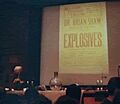Brian Duncan Shaw facts for kids
Quick facts for kids
Brian Duncan Shaw
MM TD
|
|
|---|---|

Brian Shaw in 1947
|
|
| Born | 10 February 1898 Ilkeston, Derbyshire, England
|
| Died | 7 November 1999 (aged 101) Beeston, Nottinghamshire, England
|
| Alma mater | University College, Nottingham |
| Spouse(s) |
Margaret Elsie Wheldon
(m. 1916)Alice Maud
(m. 1990) |
| Awards | Military Medal Territorial Decoration |
| Scientific career | |
| Thesis | (1927) |
| Doctoral advisor | Frederic Stanley Kipping |
Brian Duncan Shaw (10 February 1898 – 7 November 1999) was a British chemistry teacher at the University of Nottingham. He was famous for his exciting demonstrations using explosives. He was also a brave soldier who served in two World Wars.
Contents
Early Life and Family
Brian Shaw was born in Ilkeston, Derbyshire, England. He was the youngest of four children. His father made bricks, and his mother was a teacher.
In 1914, when he was 16, Brian started working at Boots the Chemist. He was learning to become a pharmacist.
He married his first wife, Margaret Elsie Wheldon, in May 1916. After she passed away in 1990, he married Alice Maud in the same year. Alice passed away in 1998, just a year before Brian.
Military Service
Brian Shaw was a soldier in both the First World War and the Second World War.
World War I Hero
During the First World War, Brian fought with the Royal Lincolnshire Regiment. He took part in major battles like the Somme, Cambrai, and Passchendaele.
In July 1917, he was awarded the Military Medal (MM). This special award was given to him for his bravery at Beaucamp, near Cambrai.
World War II Adventures
In the Second World War, Brian served with the 5th Battalion, Sherwood Foresters. In June 1940, during the Fall of France, he was cut off from his group by German tanks in Normandy.
He managed to get a bicycle and spent ten weeks hiding from the Germans. He cycled about 300 miles, trying to reach Spain. Near Poitiers, a French police officer stopped him. The officer called the Germans, and Brian was captured.
He spent the rest of the war as a prisoner of war in Germany. He was held in five different camps, including places like Tittmoning in Bavaria. While a prisoner, Brian even acted in plays, like playing the ghost in Hamlet!
Teaching Chemistry
Brian Duncan Shaw spent most of his career teaching chemistry. He worked at University College in Nottingham, which later became the University of Nottingham in 1948.
The Explosives Lecture
Starting in 1930, Brian became famous for his "Explosives Lecture." In this lecture, he showed many exciting ways to create flashes and loud bangs using chemistry. One of his famous demonstrations was called the Barking dog reaction.
He gave this amazing lecture for 60 years, even after he officially retired! In 1969, the BBC filmed his Explosives Lecture so more people could see it.
Brian also wrote several articles about chemistry, mainly for the Journal of the Chemical Society.
After retiring in 1965, he continued to give lectures. He also helped in court cases by sharing his expert knowledge of chemistry.
In 2012, a special blue plaque was placed on his home. This plaque honors important people and places. Professors Martyn Poliakoff and Brady Haran filmed this event for their popular online series, the Periodic table of videos.
The Shaw Medal
To honor Brian Shaw, the University of Nottingham created a special award in 1988. It's called the Shaw Medal. Brian himself was the very first person to receive this award!
Images for kids
-
The blue plaque at Brian Shaw's former home in Beeston.




